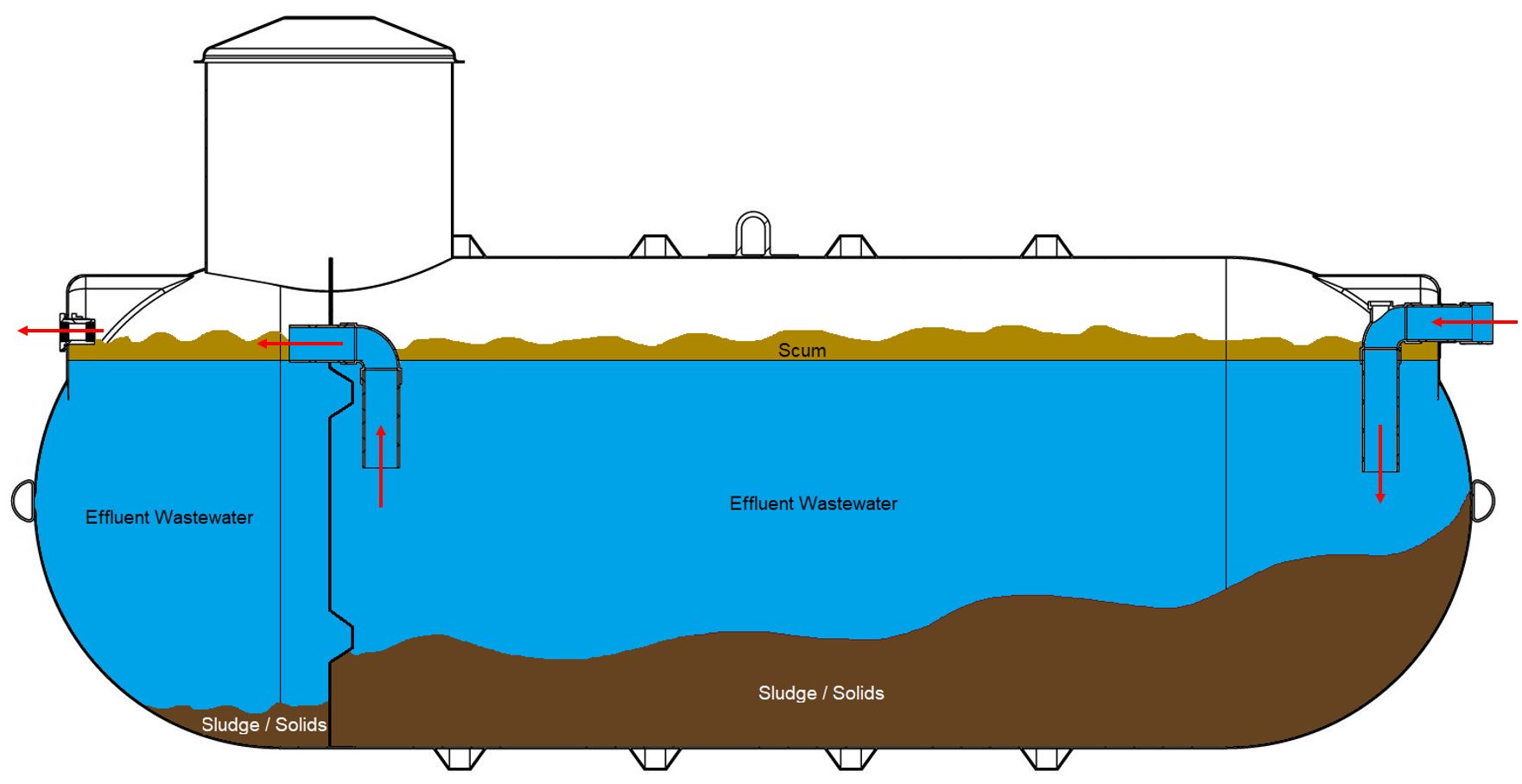The septic tank size is a critical parameter to how effective and efficient an onsite wastewater management system functions. As a homeowner looking to install an onsite wastewater management system, you may ask “What septic tank size do I need?” or “How do I determine how much wastewater or sewage will need to be treated?”. Since these households are not connected to a municipal sewage system, the septic tank must be appropriately sized to handle all of the expected wastewater output of the household.
A septic tank, sometimes referred to as pump-out tanks, trickle tanks, or siphon tanks will have a minimum of two compartments: a sedimentation (septic) chamber, and a control (effluent) chamber. The sedimentation chamber’s role is to provide sufficient time for the solid particulates to properly settle to the bottom. Meanwhile, the liquid effluent flows to the control chamber to be pumped or siphoned out to the disposal fields. Therefore, septic tank size must be designed to allow the wastewater effluent to remain in the tank for at least 1 day to undergo this sedimentation process before being pumped out of the tank. If undersized, the wastewater effluent will pass through the septic tank chambers too quickly and unsettled solids can significantly reduce the lifespan of the disposal fields.
A septic tank is commonly measured by its volume capacity, referred to as litres or imperial gallons.
Each province in Canada has its own set of requirements for onsite wastewater management systems. These jurisdictions utilize the expected peak daily sewage flows of the household as the primary factor to the sizing of the septic tank. In many cases in each jurisdiction, there are also minimum septic tank sizes / capacities (approx. 4,000 litres) that each onsite wastewater management system must meet.
The following steps to choosing your septic tank size are recommended based on Manitoba’s Onsite Wastewater Management System Regulation and may differ slightly from your local jurisdiction’s requirements. Note: This is only applicable to residences with daily sewage rates of less than 10,000 litres.
Step 1: Determine your household’s peak daily sewage rate.
- The household’s peak daily sewage flow rate should be calculated based on maximum occupancy. The maximum occupancy is calculated based on the 2 people per bedroom in households with 2 bedrooms or less, and 1.5 people per bedroom for households with 3 bedrooms or more.
- Each person is assumed to have a peak daily sewage rate of 341 litres.
For a typical 2-bedroom household, the peak daily sewage rate can be calculated as 1,364 litres.
Step 2: Determine the minimum working capacity of the septic tank.
- Multiply the peak daily sewage rate by 1.4 to get the minimum working capacity of the sedimentation (septic) chamber or 2,250 litres, whichever is greater.
- Multiply the peak daily sewage rate by 0.2 to get the minimum working capacity of the control (effluent) chamber or 340 litres, whichever is greater.
- Combine the two chamber’s minimum working capacities to get your minimum septic tank size (in volume capacity).
Since the calculated minimum working capacities of 1,910 litres and 273 litres for the sedimentation and control chambers respectively are less than the minimum amounts as specified by the Manitoba regulations, the overall minimum working capacity of the septic tank is 2,590 litres (2,250 + 340).
Important considerations for choosing the septic tank size:
The “working capacity” of a septic tank refers to the useable volume capacity of a septic tank. According to the CSA B66 standard, each septic tank must include an air space of at least 10% of the volume capacity of the tank. Beware that some tank manufacturers include their 10% air space into their tank’s volume capacity. Carlson Engineered Composites’ fiberglass septic tanks have nominal, sedimentation (septic), and control (effluent) volumes clearly listed in each of our products’ specification sheets for easy identification.
Summary
The septic tank size is a critical consideration for a sustainable onsite wastewater management system. Although each jurisdiction has its own regulations for onsite wastewater management systems, they all generally follow a similar guideline for choosing the septic tank size. The steps we have provided here are simple guidelines based on Manitoba’s regulations and may differ from your local jurisdiction’s requirements. You can find other jurisdiction’s regulations below.
As one of Canada’s leading composites manufacturers, Carlson Engineered Composites is your reliable fiberglass septic tank supplier. Our full selection of holding, pump-out, trickle, and siphon tanks are CSA-certified and ready to be an integral part of your onsite wastewater management system. Our in-house team and selection of dealers across Canada can help you properly choose the septic tank that fits your household and ensure that your onsite wastewater management system will be effective in the long-term.
Manitoba (MB) | Ontario (ON) | Saskatchewan (SK) | Alberta (AB) | British Columbia (BC) | Quebec | Northwest Territories (NT) & Nunavut (NU)




